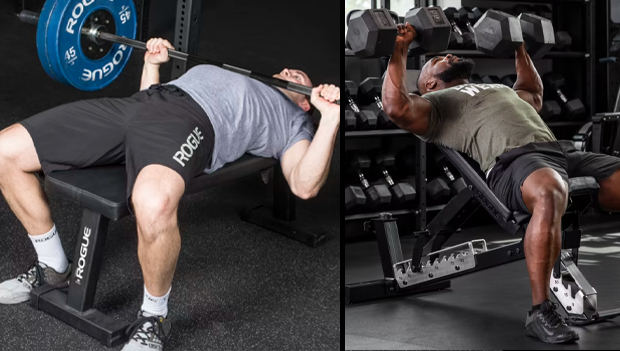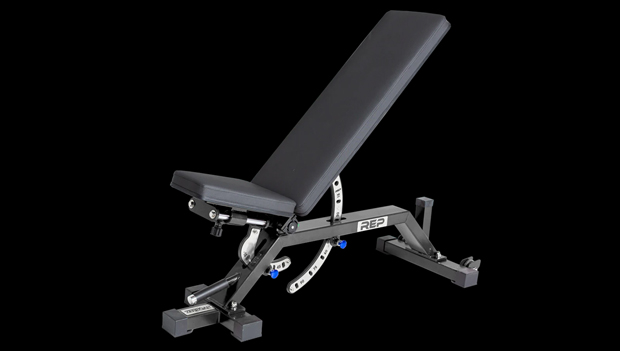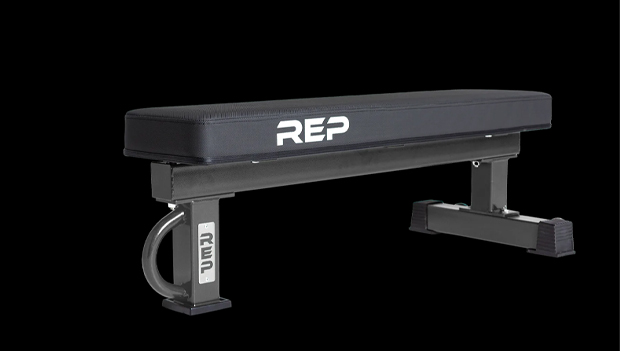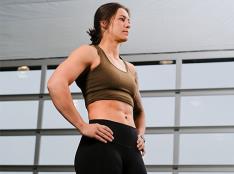
By clicking on the product links in this article, we may receive a commission fee at no cost to you, the reader. Sponsorships and affiliate commissions help support our research so we can help you find the best products. Read the full affiliate disclosure here.
An internal debate for anyone who spends enough time in the gym is the matter of an incline vs. flat benches. This has happened to me, too. My closest gym is pretty crowded at most times of the day and I’m rarely able to secure a flat weight bench for my bench press sets because they are never open.
Our Favorite Incline Benches
Our Favorite Flat Benches
I thought about buying a bench and barbell for my house, but I just don’t have the space. My go-to solution has been to switch it up and superset push-ups with power cleans or to head over to the dumbbells. Once, I even pulled an adjustable bench over to a squat rack, but that seemed to annoy my fellow gym goers.
One day, I made my normal loop around the room just to confirm that the bench press was occupied, and noticed the incline bench sitting alone in the corner. I figured I would give it a shot and load my normal warm-up weight on the bar. The experience of struggling with that weight was humbling, and it made me wonder what I had been missing by not using the incline bench. If you’ve had a similar experience or have thought about incorporating the incline bench before, read on.
Why Trust Us?
The health and safety of ACTIVE’s readers is of the utmost importance to us. To ensure your well-being when consuming protein powders, the ACTIVE.com editorial team prioritizes products that are independently tested by a third-party. We’ve also consulted with a team of nutritionists and dieticians to ensure the products we feature are of the highest standard. This helps us create the most accurate, authentic review content for our readers. More importantly, fitness may be our job, but it is also our passion. Therefore, we strive to bring you products that we trust and would personally use.
Incline Bench Press

Target Muscles
When I first started lifting weights, I avoided the incline bench because I thought the flat bench press was all I needed. Plus, I couldn’t lift as much at the incline angle as I could on a normal bench press, so why bother? But there is a reason for that.
Your chest muscle, the pectoralis major, is split into two major parts: upper and lower. An inclined angle shifts the weight and targets the upper pectoral. If you’ve never trained this specific part of your pectoral muscle then you won’t be able to lift as much weight, which can feel like a less efficient way to see results.
With proper technique, you’ll see your overall strength improve. Incorporating an incline bench press into your chest day routine is a must if you’re experiencing a plateau or have never targeted the upper pec before.
Proper Incline Bench Technique
I specified proper technique as a qualifier for seeing results, and I meant it. Most people eventually come to the realization that good technique with lower weight is a better workout than lifting heavier weights with poor technique. Sometimes we correct our technique through injury and trial and error, but if you can get ahead of the game and avoid those injuries you’ll be better off.
Proper incline bench technique starts with your angle. Thirty degrees is the ideal angle. Commercial gyms usually have a bench that is fixed at an angle, but if you’ve got a home gym or go to a smaller, private gym you may need to use an adjustable bench. On most adjustable benches the 30-degree angle will either be the first or second notch.
At 30 degrees, the primary muscle is the upper pectoral, but you’re still flat enough to recruit your lower pectoral to assist. If you go up to a 40-degree angle, the load will shift and your body will recruit your deltoids to assist. Either angle is a good workout, but if you want to grow your chest, 30 degrees is your best bet.
Once you have your angle right, you may have to play around with the amount of weight you use for the lift. Keep in mind that it is always better to use lower weights to practice proper technique.
As for the lift itself, here are the steps:
- Plant your feet flat on the ground and make sure your back and hips are even on the bench.
- Grip the bar slightly wider than shoulder width. Use the bar’s knurling to make sure your hands are evenly spaced.
- Unrack and stabilize the weight above your chest with your arms extended.
- Lower the bar straight down until it touches your upper chest. Proper form is to move slowly, making sure you control the weight all the way down instead of bouncing it off your chest.
- Push the bar back above your chest until your arms are fully extended.
Benefits of Incline Bench
- Builds overall upper body strength
- Eliminates strength imbalances in your chest muscles
- Activates the shoulders enough to improve overhead lifts
- Recruits your triceps at a different angle than a traditional bench press
Our Favorite Incline Benches
If you’re interested in a good bench for your home gym to add the incline bench press into your routine, these are my favorite adjustable benches. These brands are known for quality:
Flat Bench Press

Target Muscles
The flat bench press is the exercise most people picture when they think of “chest day.” If you’ve been to a gym at peak times, you know how hard it can be to get time on the bench press. It is simply one of the most popular exercises, for good reason.
Earlier, we noted that as you angle your body into more of an upright position, you shift the load onto the muscles higher up on your body. The inverse is also true. When you’re lying flat or parallel to the ground, you’ll recruit your most central muscles to create the lift. The flat bench press will primarily use your lower pectorals and triceps.
Technique
The setup is simpler on the flat bench than on the incline bench because you don’t have to worry about your angle, but the technique is still the most important part of your lift.
Here’s a step-by-step guide:
- Lay flat on the bench with your feet planted flat on the floor. Don’t forget to make sure your back and hips are even on the bench.
- Grip the bar slightly wider than shoulder width, using the knurling to measure an even distance.
- Lift the bar off of the rack and bring the weight directly above your chest with your arms extended.
- Slowly lower the bar until it touches the middle of your chest. Your forearms should be perpendicular to the floor, not angled.
- Drive through your feet and hips pushing the bar back up until your arms are fully extended.
Benefits
- Increase upper body power
- Build a strong chest and triceps
- Targets other major muscles like your deltoids
Our Favorite Flat Benches
It is hard to go wrong with a flat bench when you’re building your home gym. But once again, the best bench is the one you’ll use. These are a couple of recommendations to get your started from the same brands as the other benches:
Safety Precautions
- Have a spotter. The best way to stay safe with any lift is to have a spotter during your set.
- Know your limits. If you can’t have a spotter for one reason or another, make sure you know your limits. With any lift like the bench press where the weight is above your body, you have to stop before failure, or else you’re at great risk for injury.
- Practice good form. I cannot stress the importance of good form enough. It may feel good to get a pump after pushing heavy weights, but if you’re doing it with poor form, you’re sabotaging your strength and your body’s health.
FAQs About Incline vs. Flat Benches
Is incline better than a flat bench?
Incline and flat bench press each have their place. Incline is better than flat when you are targeting your upper chest and shoulders. The flat bench press is superior for targeting your lower chest and triceps.
Should you do flat bench or incline first?
Even if you’re a beginner in the gym, you should incorporate both lifts into your routine. The lift order in a particular workout is a matter of preference.
Is an incline bench really necessary?
The short answer is yes. The long answer is yes because it will push you through plateaus and correct strength imbalances in your chest muscles.
About the Author

Cory is a certified personal trainer and fitness nutrition coach. After spending six years as an educator and coach, Cory joined the ACTIVE team as a staff writer turning his passion for education toward helping ACTIVE readers live their best, healthiest lives.
Get ACTIVE on the Go


Couch to 5K®
The best way to get new runners off the couch and across the finish line of their first 5K.
Available for iOS | Android





Discuss This Article